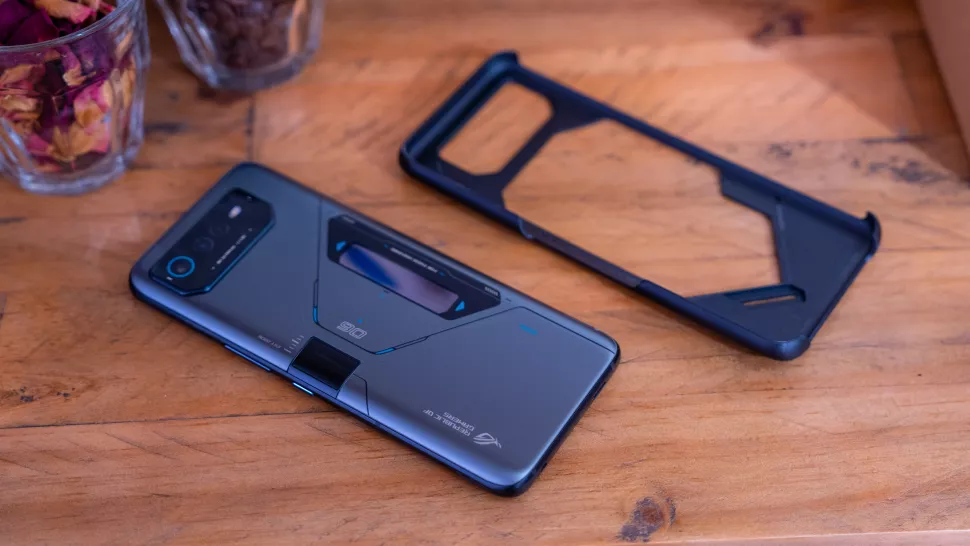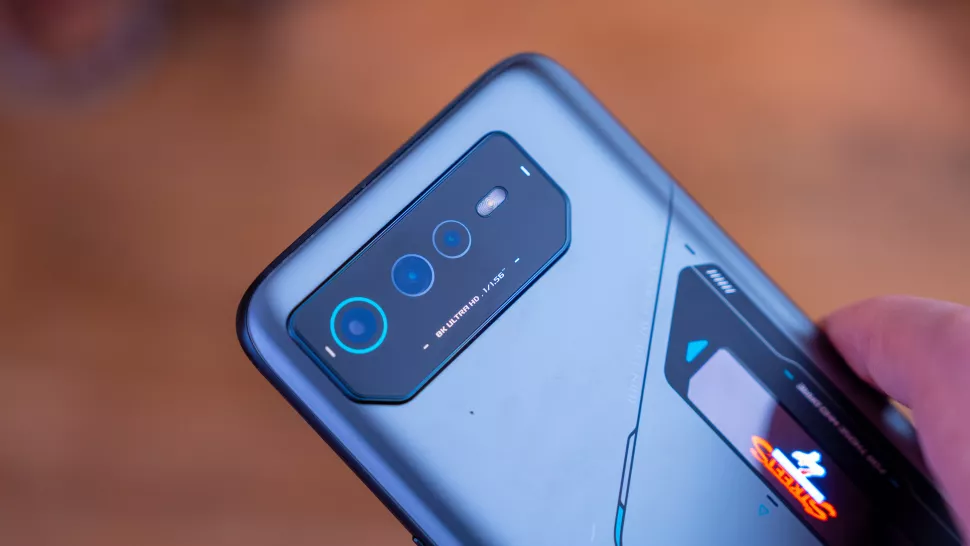- Asus ROG Phone 6D Ultimate

SPECIFICATIONS
Release date: September 2022
Weight: 247g
Dimensions: 173 x 77 x 10.4mm
OS: Android 12
Screen size: 6.78-inch
Resolution: 1080 x 2448
CPU: MediaTek Dimension 9000+
RAM: 16GB
Storage: 512GB
Battery: 6,000mAh
Rear camera: 50MP + 13MP + 5MP
Front camera: 12MP
REASONS TO BUY
- Great display
- Loud speakers
REASONS TO AVOID
- Expensive
The Asus Rog Phone 6D is proof that Asus understands how to build quality gaming smartphones. Its design is almost comparable to that of the Asus Rog Phone 6, but it has better cooling, so it won’t get too hot as you play.
A 6.78-inch full HD OLED display and MediaTek’s powerful Dimensity 9000 Plus processor make a stunning combination. Gamers will like the 165Hz refresh rate and the variety of viewing modes available. Additionally, speakers function superbly, and Asus’s software has a wealth of in-game capabilities.
The Asus Rog Phone 6D will be enjoyable if all you care about is gaming. The only drawback is the camera, which is quite ordinary.
Two-minute review
Think again if you believed that after the fantastic ROG Phone 6 introduced just two months ago, Asus will stop releasing premium gaming phones in 2022. The ROG Phone 6D and 6D Ultimate add MediaTek power, a mechanical air vent, and even a Batman Edition to the existing series.
If you still hold the opinion that Asus would cease producing high-end gaming smartphones in 2022 after the amazing ROG Phone 6 announced just two months ago, think again. The ROG Phone 6D and 6D Ultimate upgrade the current series with MediaTek power, a mechanical air vent, and even a Batman Edition.
The ROG Phone 6D and 6D Ultimate both come with a color screen around the back and are powered by MediaTek’s new Dimensity 9000 Plus processor, while advanced cooling may only be available on the Ultimate model.
Thankfully, the MediaTek chip worked well during our time with the ROG Phone 6D Ultimate. And the 6,000mAh battery and 512GB of storage on the phone contributed to its positive first impression.

Whether you select the regular model or the Ultimate, the ROG Phone 6D series employs the same camera setup as the ROG Phone 6D. Because of this, it isn’t the best in its class, even in the Ultimate, which costs £1,199 (about $1,370; AU$2,040).
Additionally, the phone lacks wireless charging and has a Full HD+ screen with a quite poor quality. Nevertheless, those latter two exclusions are acceptable for a gaming phone. The resolution is really well-optimized for gamers since wireless charging crams the chassis with additional components, which isn’t excellent for heat management, and games are produced at 1080p for Android.
The ROG Phone 6D and 6D Ultimate are therefore more of the same, with the 6D being a little more inexpensive and the 6D Ultimate being a little more expensive (and cooler). The ROG Phone 6 was the greatest gaming phone we had tested.
Despite being announced for the UK and other countries, the Asus ROG Phone 6D won’t be sold in the US. Prices are lower than those of the ROG Phone 6’s original basic model. The 6D costs £799 (about $910/AU$1,360), while the ROG Phone 6 debuted at £899 (nearly $1,023/AU$1,530) for the base configuration with 256GB storage and 12GB RAM.
However, you should expect to pay £1,199 for the ROG Phone 6D Ultimate, which is £100 more expensive than the ROG Phone 6 Pro. It’s the first time that we can remember a smartphone with a MediaTek processor costing more than one with a Qualcomm processor. However, rather than the choice of chipset, the price difference is probably due to the 6D Ultimate’s superior cooling system.

The ROG Phone 6D feels luxurious and enticing because to its curved, icy back and matte sides, but because it is somewhat slippery, you should put a cover on right away. Fortunately, a thin, hard plastic cover that works with the cooling fan and protects the edges is included in the package. It also offers a little bit more grip.
While the ROG Phone doesn’t have IP68 water or dust resistance, its screen is covered by Gorilla Glass Victus, and it is IPX4 splash-resistant even while the AeroActive Portal is open.
The AeroActive Portal is a mechanical flap on the back of the phone that raises when the fan is installed, taking design cues from ROG gaming laptops. Under the flap are heat-dissipating fins, and the CPU is attached to the opposite end of the vapor chamber.
When the flap is opened and the AeroActive Cooler fan is attached to the 6D Ultimate, Asus states that over one liter of cold air is pushed into the fins every second, immediately cooling the CPU and dissipating heat through air ducts. Very interesting, and the flap even makes use of the flip-out camera technology that Asus created for its Asus Zenfone series.
There are more connectors than usual scattered across the ROG Phone 6D’s curved metal chassis. On the side of the phone, there is a second USB connector in addition to the 3.5mm headphone jack. This is for peripherals, such as the dock and fan, but it also provides a cozy charging alternative for landscape-oriented gameplay.
The ROG Phone 6D Ultimate doesn’t come with a screen protector already fitted by Asus, but the company does make one available for separate purchase. The in-display fingerprint scanner worked flawlessly, and we also configured the phone’s face unlock feature so we could rapidly unlock it.



The 2448 x 1080 resolution of the ROG Phone 6D may appear poor for a smartphone with its price tag, but it’s appropriate for a gaming phone. Full HD is the standard for gaming display, and the smaller resolution maintains lovely, high frame rates. The fluidity of the movements, whether playing games, navigating websites, or scrolling through social media feeds, makes up for any clarity loss.
The ROG Phone 6D offers exceptional screen quality thanks to Asus and Samsung’s collaboration. Its rich colors make it ideal for gaming and viewing movies, and its adjustable brightness, which can be adjusted indoors to 800nits of brightness in extreme darkness, is excellent. When under direct sunlight, you should absolutely engage the high-brightness option by switching on auto-brightness, which reaches a maximum brightness of 1200nits.
The ROG Phone 6D offers a fantastic screen-quality experience thanks to Asus and Samsung’s collaboration. The adjustable brightness is amazing indoors, going super-dark and ascending up to 800nits. Its colors are rich, making it ideal for gaming and watching movies. By enabling auto-brightness, which reaches its maximum brightness of 1200nits in direct sunshine, you should absolutely engage high-brightness mode.
The device has three cameras overall, including a 50MP, f/1.9 primary camera, a 13MP, f/2.2 ultra-wide camera, and a 5MP, f/2 macro camera. Only the primary camera has autofocus, and both the macro and ultra-wide lenses can focus as close as 4 cm.

This is not to imply that the ROG Phone 6D cannot take quality pictures. When shooting up-close objects, it captures a pleasingly modest depth, and photos taken in excellent lighting are, predictably, rich in detail.
Uncomfortably, Asus overprocesses its photographs in auto mode, resulting in photos that are densely contrasted. However, it doesn’t do much to reduce noise, so when you zoom in, dark regions shot in situations with mixed illumination appear grainy.
Many people will enjoy the ROG Phone 6D’s vibrant shots, but if you want to really make the most of it on special occasions, you should shoot in RAW and hand-edit your images. It’s also important to keep in mind that without OIS, shaking can inadvertently ruin your photographs, so try to keep your phone as steady as you can to give it the greatest chance of capturing a quality picture.
It’s noteworthy to note that the phone’s night mode is superior to its auto mode and that it immediately activates as it becomes dark, whether using the primary or ultra-wide cameras.
Similar to the primary camera, the ultra-wide camera has drawbacks, but when night mode isn’t on, they stand out a little more. The macro camera is the least effective of the three. By using the primary camera and cropping in, we were able to achieve superior macro results the majority of the time.

The 12MP IMX663 selfie sensor on the ROG Phone 6D is one of the camera system’s most outstanding features for both photo and video shooting. The front camera performs a decent job at taking photographs that are pleasing and natural, even though the detail isn’t very noteworthy.
The Qualcomm Snapdragon 8 Plus Gen 1 was initially presented by the Asus ROG Phone 6, and the MediaTek Dimensity 9000 Plus—the company’s first flagship processor—was first made available in the West in the ROG Phone 6D.
The MediaTek Dimensity 9000 Plus 5G is manufactured using a 4nm technology and comes equipped with a Mali G710 MC10 GPU and a CPU clocked up to 3.2GHz. It contains 512GB of storage and 16GB of RAM, both top-tier capacities,
The 6D Ultimate’s AeroActive Portal is in the centre of the phone, similar to how the ROG Phone 6’s CPU (the heat source) is positioned in the middle of the device.
It accomplishes a couple nifty things to place the processor and cooling system in the middle of the phone: it disperses heat away from your hands, especially while playing in landscape position. Additionally, it pulls it away from two of the metal frame’s heat conductors and places it precisely where the provided fan attachment should be.
The Asus ROG Phone 6 Pro ran quite cool, but the 6D Ultimate runs even cooler. We were able to play Genshin Impact for an hour at the highest graphics settings while keeping the temperature below 40 degrees by using the AeroActive Cooler fan.
Armory Crate and Game Genie are the greatest software upgrades for the ROG Phone 6 series. You may access the ROG community and your personal profile on the first, Armory Crate, where you can also locate your games, manage your official accessories, discover new high-refresh-rate games, and find your games.
Additionally, you can launch the AeroActive Portal from here and operate the OLED screen that wraps around the phone’s back.
Asus’s in-game software, Game Genie, enables game-specific profiles, including mapping keys, creating macros, and configuring crosshairs, to name just a few.